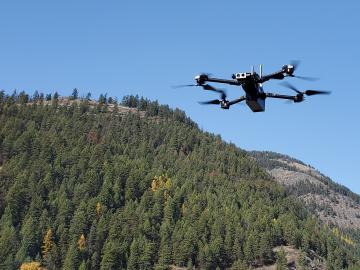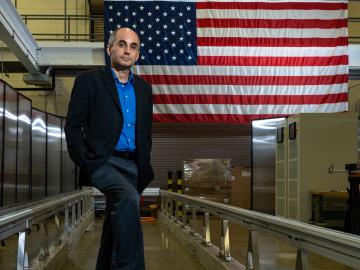
Filter News
Area of Research
- Biology and Environment (11)
- Computer Science (3)
- Energy Frontier Research Centers (1)
- Energy Science (40)
- Fusion and Fission (6)
- Isotope Development and Production (1)
- Isotopes (1)
- Materials (59)
- Materials Characterization (1)
- Materials for Computing (6)
- Materials Under Extremes (1)
- National Security (3)
- Neutron Science (18)
- Nuclear Science and Technology (1)
- Quantum information Science (1)
- Supercomputing (22)
News Type
News Topics
- (-) Energy Storage (43)
- (-) Grid (16)
- (-) Materials Science (56)
- (-) Nanotechnology (29)
- (-) Quantum Computing (13)
- (-) Quantum Science (31)
- 3-D Printing/Advanced Manufacturing (49)
- Advanced Reactors (12)
- Artificial Intelligence (35)
- Big Data (8)
- Bioenergy (25)
- Biology (26)
- Biomedical (17)
- Biotechnology (10)
- Buildings (15)
- Chemical Sciences (35)
- Clean Water (2)
- Composites (12)
- Computer Science (63)
- Coronavirus (17)
- Critical Materials (11)
- Cybersecurity (17)
- Education (3)
- Element Discovery (1)
- Environment (38)
- Exascale Computing (13)
- Fossil Energy (1)
- Frontier (16)
- Fusion (17)
- High-Performance Computing (32)
- Isotopes (20)
- ITER (2)
- Machine Learning (13)
- Materials (60)
- Mercury (2)
- Microelectronics (1)
- Microscopy (17)
- Molten Salt (3)
- National Security (18)
- Neutron Science (54)
- Nuclear Energy (28)
- Partnerships (31)
- Physics (26)
- Polymers (13)
- Security (12)
- Simulation (10)
- Space Exploration (3)
- Statistics (1)
- Summit (22)
- Transportation (26)
Media Contacts

Researchers at ORNL and the University of Tennessee, Knoxville, discovered a key material needed for fast-charging lithium-ion batteries. The commercially relevant approach opens a potential pathway to improve charging speeds for electric vehicles.

When Hurricane Maria battered Puerto Rico in 2017, winds snapped trees and destroyed homes, while heavy rains transformed streets into rivers. But after the storm passed, the human toll continued to grow as residents struggled without electricity for months. Five years later, power outages remain long and frequent.

ORNL has been selected to lead an Energy Frontier Research Center, or EFRC, focused on polymer electrolytes for next-generation energy storage devices such as fuel cells and solid-state electric vehicle batteries.

ORNL Corporate Fellow and Center for Nanophase Materials Sciences researcher Bobby Sumpter has been named fellow of two scientific professional societies: the Institute of Physics and the International Association of Advanced Materials.

As climate change leads to larger and more frequent wildfires, researchers at ORNL are using sensors, drones and machine learning to both prevent fires and reduce their damage to the electric grid.

Scientists at ORNL used neutron scattering to determine whether a specific material’s atomic structure could host a novel state of matter called a spiral spin liquid.

Burak Ozpineci, a Corporate Fellow and section head for Vehicle and Mobility Systems Research at Oak Ridge National Laboratory, is one of six international recipients of the eighth Nagamori Award.

Jagjit Nanda, a distinguished staff scientist, has been elected a fellow of the Materials Research Society. The lifetime appointment recognizes outstanding members whose sustained and distinguished contributions to the advancement of materials research are internationally recognized.

ORNL scientists will present new technologies available for licensing during the annual Technology Innovation Showcase. The event is 9 a.m. to 3 p.m. Thursday, June 16, at the Manufacturing Demonstration Facility at ORNL’s Hardin Valley campus.

Researchers at ORNL are teaching microscopes to drive discoveries with an intuitive algorithm, developed at the lab’s Center for Nanophase Materials Sciences, that could guide breakthroughs in new materials for energy technologies, sensing and computing.


